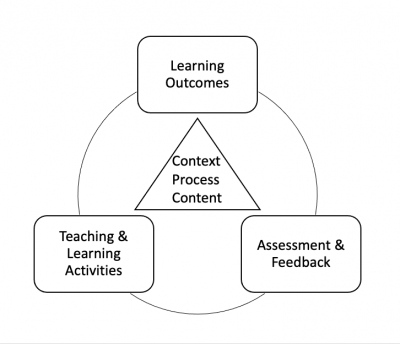In experiential learning, the student manages their own learning, rather than being told what to do and when to do it. (Schwartz, 2012)
Experiential learning is more than “learning by doing”; it should be meaningful and transformative.
Students need:
- to generate meaning on course concepts;
- opportunities for structured reflection;
- multiple ways of interacting with new information;
- to be actively engaged – e.g., doing, designing, creating, reflecting, analyzing, evaluating, generating and suggesting solutions.
The activities need:
- to be aligned with the learning outcomes of your course/program;
- to use relatable and relevant materials;
- to be meaningfully assessed.
Getting Started
Before you jump into planning your experiential learning activity, consider how it will fit into the bigger picture of your course.
Constructive alignment (Fig. 1) is when the four elements of course design are working in harmony:
- Context. What’s the context of your course (class size/level, TAs, etc.)?
- Learning outcomes. What do you want your students to know, be able to do, and value by the end of the activity?
- Assessment and feedback. How will you assess the activity to provide you with evidence of (and feedback on) students’ learning?
- Teaching and learning activities. What activities will help students meet the learning outcomes?

Figure 1. Constructive alignment in course design (from Biggs, 1996)
Context
The context of your course will determine what kinds of experiential learning activities you can run. Consider:
- Students (level of study, age, motivation, past knowledge/experiences, life situation, etc.)
- Classroom/scheduling (class size, course schedule, physical/virtual environment, delivery mode, etc.)
- Resources (TAs, equipment, lab space, etc.)
- Program (core/elective course, mandated assessments (e.g., % final exam), contact time requirements, etc.)
For example, smaller class sizes and more advanced learners may be more conducive experiential learning activities that require significant coordination or involve external stakeholders, like in community-based activities. Some activities like case studies and some types of field experiences can also suit large class sizes.
If your course context makes it difficult for you to provide experiential learning opportunities, consider instead pointing your students to co-curricular activities.
Learning outcomes
Learning outcomes are statements that describe the knowledge, skills, and attitudes students are expected to develop in your course. Learning outcomes are the backbone of any course. Learn more
Read about articulating learning outcomes for skills development.
Sample learning outcomes for experiential learning:
Experiential learning outcomes can target any of the three domains of Bloom’s taxonomy. If you’re planning to have career-related learning outcomes, see this article in University Affairs.
Find more sample learning outcomes on the Experiential Learning Brightspace page
Assessment and feedback
Assessments provide you with evidence of students’ progress in meeting an activity/course’s learning outcomes. Assessments, especially formative assessments, also provide valuable feedback to students about their progress and how they might improve their performance.
A central component of experiential learning is reflection, and so assessments should be based at least in part on students’ reflections on their experience. Learn more
Find more sample reflection prompts and assessment tools on the Experiential Learning Brightspace page
Teaching and learning activities
Activities should be aligned with learning outcomes and assessments and be feasible within the context of the course. Avoid activities that sound fun or flashy but do not contribute to the ultimate aims of the course, and activities that are excessively time- or resource-intensive for you and/or the students.
Carleton has defined 12 types of experiential learning activities for the classroom, community, and/or workplace. Browse each page below to learn more about each type.
In the Classroom
- Case studies
- Interactive simulation
- Performance-based learning
- … and more!
In the Community
- Community-based learning
- Community-based research
- Community service learning
Find more activity ideas and resources on the Experiential Learning Brightspace page
Next Steps
- Learn more about activities you can run in the classroom, community, or workplace.
- Get inspired about reflection and assessment, including sample prompts and rubrics.
- Find the forms and resources you might need (risk/insurance, ethics, etc.).
- Participate in workshops, symposia, and other events to meet other instructors doing experiential learning and share ideas.
- Read from faculty and experts about integrating experiential learning into teaching, for example this article from Faculty Focus.
- Can’t find what you’re looking for? Contact us.